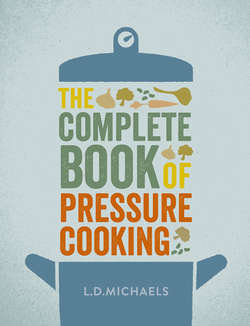Читать книгу The Complete Book of Pressure Cooking - L.D. Michaels - Страница 41
ОглавлениеBasic Chinese Broth
20–30 minutes
cooked or uncooked chicken or pork scraps
knob of fresh ginger root, sliced
sugar, to taste
salt
Proceed as for Chicken Stock but adding the ginger and sugar and salt to taste, and don’t add any vegetables on reuse. This recipe gives a basis for a large number of Chinese soups; a small quantity of the broth, together with a trace of soy sauce, can be added to most quick stir-fry dishes at the end of the cooking process.
How to Clarify a Meat Stock
It is often not necessary to clarify meat stocks unless you wish to make a special feature of a very clear appearance, as in classic consommé. However, here is the way to do it – the secret is never to let the soup boil; it must only simmer.
For every litre (13/4pts) fluid you need 1 slightly beaten egg white (reserve the egg yolk for another purpose) and a crushed eggshell.
Let stock settle and add egg white and eggshell very carefully. Slowly heat up, avoiding any turbulence in the fluid. A thick, crusty foam will form and in this you should clear a small opening to check that no boiling takes place. Simmer for 10–15 minutes and then remove from heat source. Push foam to one side and ladle out stock carefully, pouring it through a muslin cloth into a bowl while it is still hot. Cool and refrigerate. If the mixture boils up at all, cloudiness will result and you’ll have to start all over again.
Soup Thickeners
If you want a thick soup, there are various ways of achieving the desired result. The recipes that follow will give some practical applications, but here are the principal methods and the ways in which they are of use:
1 Puréeing. You simply pass the entire fluid and the meat and vegetable fragments through a sieve or into a blender. If you decide to buy a blender, don’t get the very inexpensive sort – one with a heatproof goblet will allow you to blend your soups straight from the cooker.
2 Adding flour. You can use any sort of ordinary (i.e. not self-raising) flour at the rate of 25g to 250ml (1 oz to ½pt) added at the beginning of the cooking time.
3 Roux. Equal parts of butter and flour are cooked into a white paste and then added. Or, you can add milk to the roux first to make a thickish fluid, which is then cooked for a few minutes thoroughly, to get a velouté or plain white sauce, which is used for cream of tomato and cream of asparagus soups.
4 Cornflour or arrowroot. The same results, with rather more ease, can be obtained from cornflour and also from arrowroot, neither of which are quite so prone to lumpiness as ordinary wheat flour. Flour acts as a binder for bean soups.
5 Potato. The “dirty snow storm” trick. A medium-sized potato cut up and blended while still raw into 1lt (13/4pts) water will make a very effective thickener. You can increase the amount of potato if you wish, but it bulks out in the cooking process. The effect, usually called parmentier in French cooking, gives a bulky reassuring consistency to meat and vegetable soups. Potato and leek soups are of course well known. If you don’t have a blender, the best thing to do is to use cooked mashed potato, which is then whisked into the soup with a fork either before or after the soup-cooking process. Alternatively, a single tablespoon of instant mashed potato in 500ml (1pt) hot soup will have the same effect.
